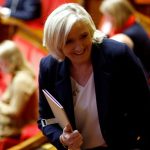
Investing.com — While recent economic data has shifted market expectations toward the Federal Reserve potentially pausing its rate cuts, conditions for such a move remain stringent, Deutsche Bank strategists said in a note.
Following the Fed’s 50-basis-point reduction in September, strategists note a pivot in sentiment, with speculation on when the Fed might skip a meeting.
However, Deutsche Bank’s policy rule analysis highlights that further reductions are feasible under the current economic conditions, with the Fed likely to implement a 25-basis-point cut in December, keeping rates within the upper end of policy rule prescriptions.
For the Fed to consider pausing, the bank’s strategists outline two primary conditions. First, inflation would need to prove “stickier,” with core PCE inflation consistently rounding to 0.3%, signaling persistent price pressures that could make further cuts less advisable.
Second, downside risks to the labor market would need to diminish, with evidence of stable or improving indicators like payroll growth, a steady unemployment rate (targeted at 4.1% or lower), and a recovery in other labor metrics such as the quits and hiring rates.
“These conditions could be in place by December, though hurricane-impacted data and the November CPI report coming during the December blackout period present complications,” strategists wrote.
“Our baseline is that the Fed will deliver a 25bp reduction at that meeting given that they should still be able to comfortably reduce rates below 4.5%,” they added.
As 2025 approaches, the case for a potential pause in rate cuts may strengthen, Deutsche Bank suggests.
Key drivers include seasonal inflation effects that could temporarily lift inflation figures, likely making Fed officials cautious about further cuts.
“The Fed will be closer to estimates of neutral, a repeat of residual seasonality could lift inflation early next year, and the election outcome could add to hawkish risks for the Fed,” strategists continued.
“We therefore see risks tilted towards an earlier skip/ pause than in our baseline (Q2 2025).”
As for the election outcome, Deutsche Bank’s team points out that a red sweep without tariffs would be a clearly hawkish result for the Fed, while other scenarios, such as a Trump presidency with tariffs or a Harris administration with a Republican Senate, could each present unique hawkish pressures depending on inflation levels and economic strength.
The Fed’s rate trajectory remains sensitive to its estimates of the neutral rate—often linked to “r-star” or the equilibrium rate.
Deutsche Bank observes that while policy rules suggest a nominal neutral rate around 3.5%, the precise rate is hard to pinpoint. This ambiguity poses a challenge; with the current policy rate only about 125 basis points above Deutsche Bank’s neutral rate estimate, the Fed has limited room for further cuts before approaching the neutral range.
Thus, while a December rate cut is likely, “there will be some element of data dependence to policy decisions beyond November,” strategists note, with early 2025 potentially marking a pivot to a pause if inflation and labor conditions support it.






